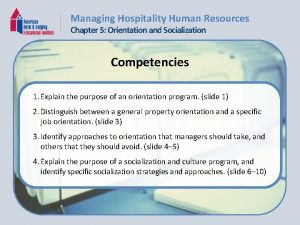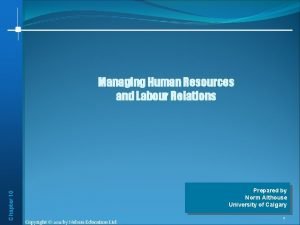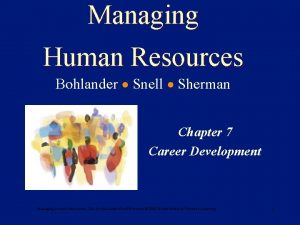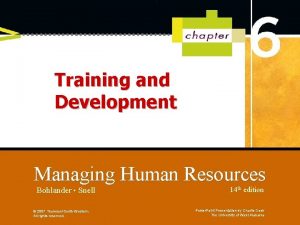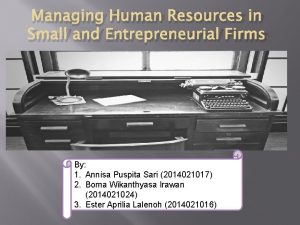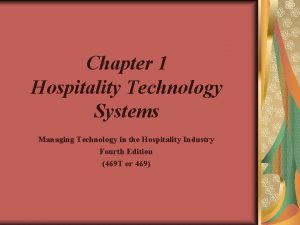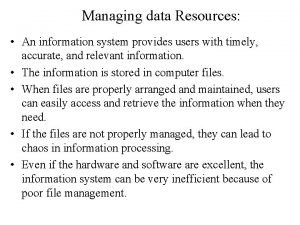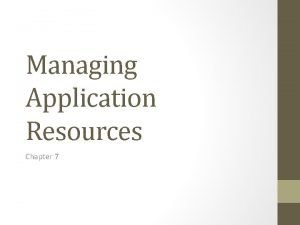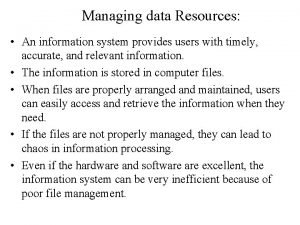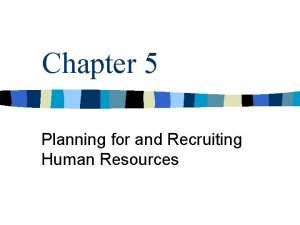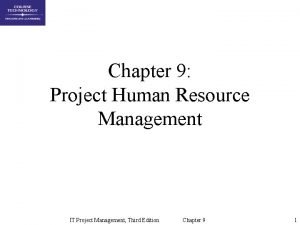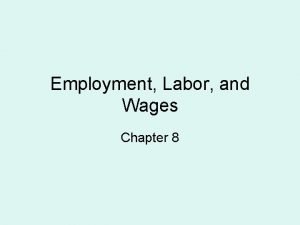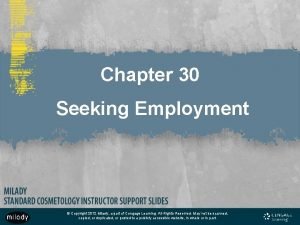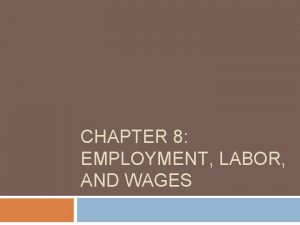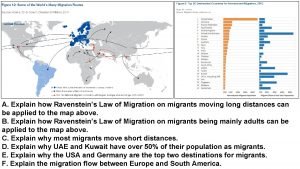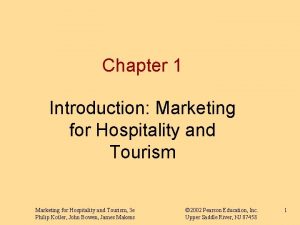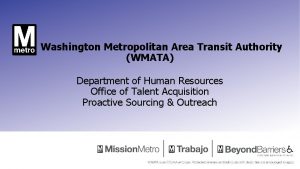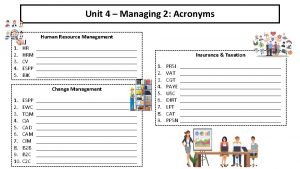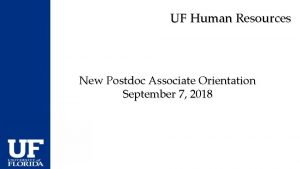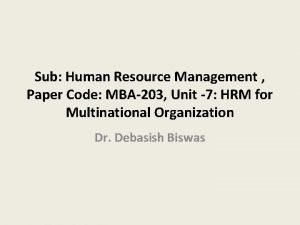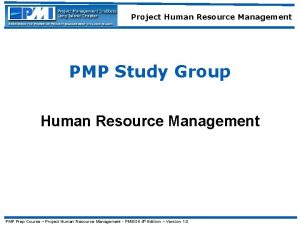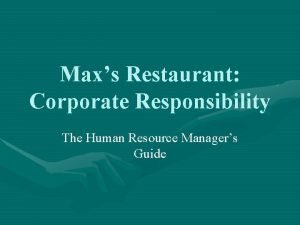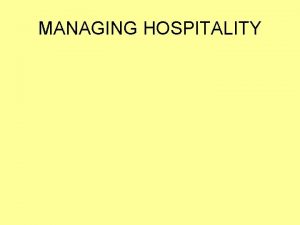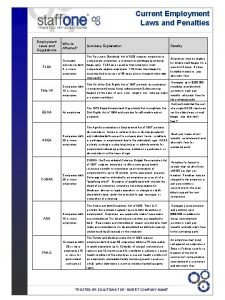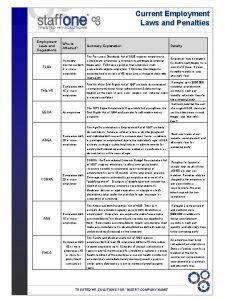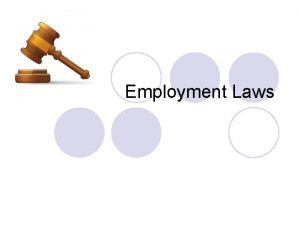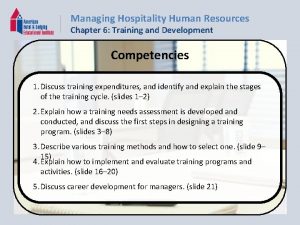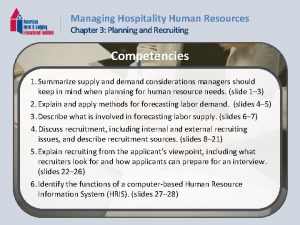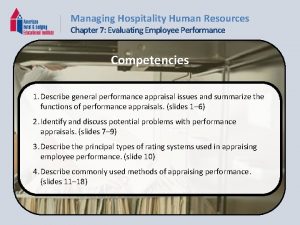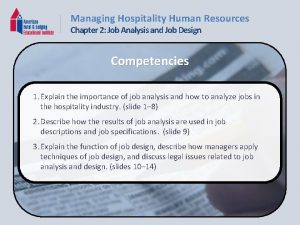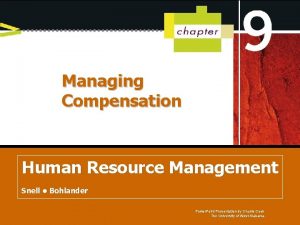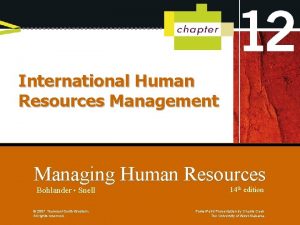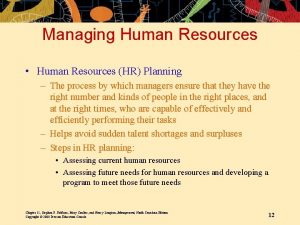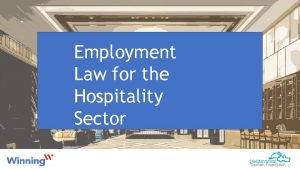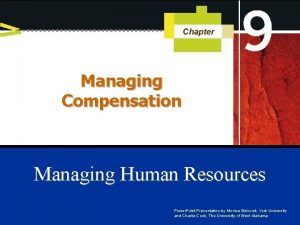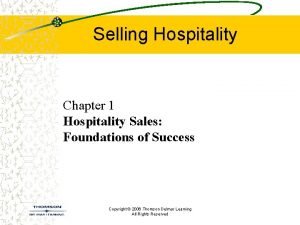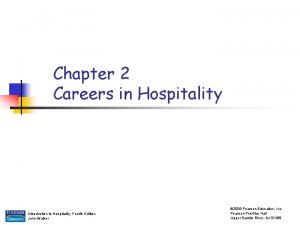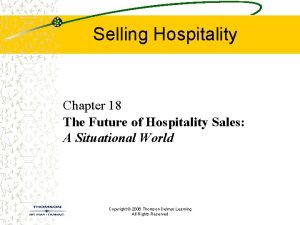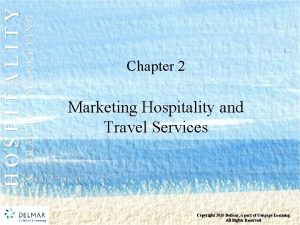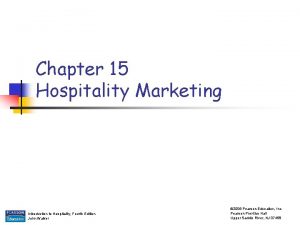Managing Hospitality Human Resources Chapter 1 Employment Laws













































- Slides: 45

Managing Hospitality Human Resources Chapter 1: Employment Laws and Applications Competencies 1. Describe the EEOC and distinguish between EEO laws and affirmative action. (slide 1– 4) 2. Describe the evolution of EEO legislation from the 1960 s through today. (slides 5– 22) 3. List major areas of EEO abuse and litigation, and identify various critical EEO issues. (slides 23– 39) 4. Define disability, and describe the Americans with Disabilities Act (ADA) and its implications for human resource managers at hospitality operations. (slides 40– 44)

Managing Hospitality Human Resources Chapter 1: Employment Laws and Applications Defining Discrimination Human resources management is the practice of legal discrimination; i. e. , it adheres to the guidelines, laws, and regulations of the Equal Employment Opportunity Commission (EEOC). Slide 1

Managing Hospitality Human Resources Chapter 1: Employment Laws and Applications Equal Employment Opportunity Commission • The EEOC is the federal commission created by the Civil Rights Act of 1964 to establish and monitor employment standards in the U. S. • The EEOC has three principal roles: 1. Overseeing the administration of existing EEO laws/regulations, and referring violation charges to state or local EEO agencies. 2. Issuing guidelines for Title VII compliance. 3. Gathering information for analyzing patterns of compliance and discrimination in the United States. Slide 2

Managing Hospitality Human Resources Chapter 1: Employment Laws and Applications Departments of Labor and Homeland Security • The DOL aims to foster, promote, and develop the welfare of U. S. wage earners, job seekers, and retirees; improve working conditions; advance opportunities for profitable employment; and assure work-related benefits and rights. • The mission of the DHS is to prevent terrorist attacks within the U. S. ; reduce the vulnerability of the U. S. to terrorism; and minimize the damage, and assist in the recovery, from terrorist attacks that do occur within the U. S. The DHS is also engaged in discrimination issues through programs such as the U. S. Border Patrol, and the U. S. Immigration and Customs Enforcement (ICE). Slide 3

Managing Hospitality Human Resources Chapter 1: Employment Laws and Applications EEO vs. Affirmative Action • EEO refers to the laws and regulations that protect the rights of an identified group or class. • Affirmative action represents an obligation employers have to hire members of protected groups to overcome past discriminatory practices. • All employers are required to abide by EEO laws and regulations, but only employers holding federal and sometimes state contracts are required to have affirmative action programs. • Reverse discrimination: Discrimination against a member of a majority group in favor of a minority solely on the basis of race, color, religion, sex, age, disability status, or national origin. Slide 4

Managing Hospitality Human Resources Chapter 1: Employment Laws and Applications Evolution of EEO Legislation • The Equal Pay Act of 1963 • Title VII of the Civil Rights Act of 1964 • Age Discrimination in Employment Act of 1967 • Vocational Rehabilitation Act of 1973 • Acts affecting veterans • Pregnancy Discrimination Act of 1978 • Retirement Equity Act of 1984 • Immigration Reform and Control Act of 1986 • Employee Polygraph Protection Act of 1988 • Drug-Free Workplace Act of 1988 • The Civil Rights Act of 1991 • The Family and Medical Leave Act of 1993 Slide 5

Managing Hospitality Human Resources Chapter 1: Employment Laws and Applications Equal Pay Act of 1963 • Passed as an amendment to the Fair Labor Standards Act of 1938, this act was the evolutionary starting point of the EEO movement. • Requires that men and women working for the same organization be paid the same rate of pay for work that is substantially the same. • Jobs are considered to be “substantially” the same when they require equal skill, effort, and responsibility, and are performed under similar working conditions. Slide 6

Managing Hospitality Human Resources Chapter 1: Employment Laws and Applications Title VII of the Civil Rights Act of 1964 • Applies to employers with 15 or more employees. • Prohibits unfair employment discrimination based on race, color, sex, religion, and national origin. • Holds two theories of discrimination: • Disparate treatment: Occurs when an employer treats one individual differently because of the person’s race, sex, color, religion, national origin, or other protected • characteristic. Disparate impact: Occurs when an employer doesn’t intend to discriminate but does something that disadvantages more members of one group than another. Slide 7

Managing Hospitality Human Resources Chapter 1: Employment Laws and Applications Business Necessity, BFOQs, and Other Exceptions to Title VII • Two possible defenses are possible for charges of discrimination brought under the Civil Rights Act of 1964: • Business necessity: Employer must show that the practice is essential to its business. • Bona fide occupational qualifications: Based on the need to hire certain types of people for specific jobs; discrimination based on sex, religion, and national origin is okay if a BFOQ makes it necessary. • Other exceptions include seniority and seniority/merit systems, job-related pre-employment inquiries, and testing. Slide 8

Managing Hospitality Human Resources Chapter 1: Employment Laws and Applications Age Discrimination in Employment Act of 1967 • Prohibits employment discrimination on the basis of age against people 40 years old or older. • All employment actions affecting employees who are 40 or older are subject to scrutiny under the ADEA. • All private employers with 20 or more employees and all unions with 25 or more members must comply. Slide 9

Managing Hospitality Human Resources Chapter 1: Employment Laws and Applications Vocational Rehabilitation Act of 1973 • Requires all employers holding federal contracts of $25, 000 or more to employ “qualified” individuals with disabilities and to make “reasonable accommodations” as needed. • Companies holding federal contracts of $50, 000 or more must also file a written affirmative action report annually with the EEOC. • Considers a person to have a disability if he or she has either a physical or mental impairment, has a record of such impairment, and/or is viewed by others as having such an impairment. Slide 10

Managing Hospitality Human Resources Chapter 1: Employment Laws and Applications Acts Affecting Veterans • Under the Vietnam Era Veterans’ Readjustment Assistance Act of 1974, Vietnam veterans receive protected group status for a period of four years after their discharge. • The Selective Training and Service Act of 1940 requires employers to rehire veterans—within 90 days of reapplication and no loss of seniority—who leave a job for military service and then apply for reemployment upon completion of service. • The Veterans Benefit Improvement Act of 2005 requires all employers to notify employees of their rights and responsibilities under the Uniformed Services Employment and Reemployment Rights Act of 1994. Slide 11

Managing Hospitality Human Resources Chapter 1: Employment Laws and Applications Pregnancy Discrimination Act of 1978 Prohibits employers from: • Stipulating the beginning and ending dates of a pregnant employee’s maternity leave. • Refusing to hire pregnant applicants as long as they can perform the major functions of the job. • Providing health insurance that does not cover pregnancy or imposes high costs for pregnancy coverage. • Limiting pregnancy benefits to married workers. • Discriminating between men and women regarding pregnancy benefits. Slide 12

Managing Hospitality Human Resources Chapter 1: Employment Laws and Applications Retirement Equity Act of 1984 • Requires companies to count: • All service since the age of 18 in determining vesting in retirement benefits. • All earnings since age 21, even if there are breaks in service of up to five years. • Applies to both sexes but has the most impact on women. • States that: • Pension benefits may be considered a joint asset in divorce settlements. • Employees must provide survivor benefits to spouses of fully vested employees who die before reaching the minimum retirement age. Slide 13

Managing Hospitality Human Resources Chapter 1: Employment Laws and Applications Immigration Reform and Control Act of 1986 • Prohibits employers with four or more employees from discriminating against applicants on the basis of citizenship or nationality. • Mandates that employers must verify citizenship status on all employees hired after November 6, 1986. • Does not affect foreign workers hired before the enactment of the IRCA. • Places the burden on the employer to verify newly hired employees are authorized to work in the U. S. by completing the I-9 form. Slide 14

Managing Hospitality Human Resources Chapter 1: Employment Laws and Applications Authorized Documentation • About 31 percent of undocumented immigrants in the U. S. work in the hospitality industry. • Employers may rely on items such as a U. S. passport, certification of naturalization, birth certificate, or Social Security card to verify an applicant’s citizenship status. . • Applicants may also be eligible to work if they possess a valid foreign passport and a U. S. employment authorization or a green card. Slide 15

Managing Hospitality Human Resources Chapter 1: Employment Laws and Applications Employee Polygraph Protection Act of 1988 • Prohibits the use of polygraphs in about 85 percent of the employment situations in which they were previously used. • Protects employees from dismissal, discipline, and discrimination solely on the basis of their refusal to submit to a polygraph exam. • Allows employers to utilize polygraph tests to investigate economic loss or injury when they have reason to believe an employee was involved, and if they afford the employee other protection. Slide 16

Managing Hospitality Human Resources Chapter 1: Employment Laws and Applications Drug-Free Workplace Act of 1988 • Does not mandate a drug-free work environment for all private employers. • Requires that federal contractors establish policies and procedures to prohibit drug abuse and make a good faith effort to sustain drug-free working environments. • Requires federal contractors to publish company rules about drug possession and use of controlled substances, the establishment of drug awareness programs, and the administration of discipline for employees convicted under drug statutes. Slide 17

Managing Hospitality Human Resources Chapter 1: Employment Laws and Applications Civil Rights Act of 1991 • Allows for employees to sue for damage awards, whereas previously employees could receive only back pay and equitable relief. • Permits individuals to request a trial by jury if they believe they have been discriminated against. • Mandates that criteria used by a business for hiring decisions must be “job related for the position in question and consistent with business necessity. ” • Exempts employers with fewer than 15 employees from payment of punitive damages except in cases of intentional discrimination. Slide 18

Managing Hospitality Human Resources Chapter 1: Employment Laws and Applications Family and Medical Leave Act of 1993 • Requires employers with 50 or more employees within a 75 mile radius to offer up to 12 weeks of unpaid (but jobprotected) leave during a 12 -month period for birth; adoption; care for an ill parent, spouse, or child; or medical treatment. • Does not require employers to provide these benefits to the highest paid 10 percent of executives. • Applies to males and females equally, but employers who employ both husband wife can limit their total leave to 12 weeks annually. • Mandates that employers must continue health coverage while employees are on leave. Slide 19

Managing Hospitality Human Resources Chapter 1: Employment Laws and Applications Executive Orders and Affirmative Action • Executive orders are issued by the president and administered by the Department of Labor’s Office of Federal Contract Compliance Programs (OFCCP). Important executive orders dealing with affirmative action include: • Executive Orders 11246 and 11375, which requires employers with federal contracts of $10 Kor more annually to engage in affirmative action, and employers with 50 or more employees and $50 K in contracts to develop affirmative action plans. • Executive Order 11478, which mandated that all U. S. government agencies and contractors base employment policies on merit and fitness, rather than gender, race, color, or national origin. Slide 20

Managing Hospitality Human Resources Chapter 1: Employment Laws and Applications Major Cases and Interpretations • Griggs v. Duke Power Company, 1971: Educational and testing practices are more heavily scrutinized for discriminatory elements. • Steelworkers v. Weber, 1979: Ruled that companies and unions could establish quotas to eliminate racial imbalance in the workplace. Later modified by two other rulings. • Newport News Shipbuilding and Dry Dock Co. v. EEOC, 1983: Ruled that employers must treat male and female employees equally when providing health benefit coverage for spouses. • Arizona v. Norris: Ruled that employer-sponsored retirement plans must pay equal benefits to men and women. • Johnson v. Transportation Agency, 1987: Ruled that employers can implement affirmative action policies to correct gender discrimination. Slide 21

Managing Hospitality Human Resources Chapter 1: Employment Laws and Applications State Employment Laws • State and local EEO laws can provide much broader protection than federal EEO legislation, because companies of all sizes are generally required to follow state EEO regulations. • Many states and municipalities: • Have enacted laws that protect groups not included in the federal protection plan. • Prohibit discrimination based on physical appearance, political affiliation, contagious diseases, etc. • Employers should conduct a careful review of state and local EEO laws before establishing a business in any locale. Slide 22

Managing Hospitality Human Resources Chapter 1: Employment Laws and Applications Major Areas of Abuse and Litigation in Hospitality Operations • Recruitment and selection • Religious discrimination • Age discrimination • Seniority • Reverse discrimination • Recruitment advertising • Employee benefits and sex discrimination • Wrongful discharge Slide 23

Managing Hospitality Human Resources Chapter 1: Employment Laws and Applications Recruitment and Selection • Recruiting and hiring underqualified candidates simply to fill vacancies can be construed as discriminatory. • Under the four-fifths rule, the selection of any racial, ethnic, or gender group at a rate that is less than 80 percent of the group with the highest selection rate is regarded as strong evidence of adverse impact. • Selection tests are considered illegal if they measure issues not related to job specifications. • Selection based on employee referrals and discrimination based on arrest records can also be problematic. Slide 24

Managing Hospitality Human Resources Chapter 1: Employment Laws and Applications Age Discrimination • The ADEA specifically prohibits discrimination against employees age 40 and older in all employment conditions. • Some provisions are made for business necessities, but for the most part image is not considered a business necessity. • Examples of age discrimination include: • Refusing to put older workers in training programs. • Not promoting older employees. • Forcing older employees to retire or move to less desirable positions. Slide 25

Managing Hospitality Human Resources Chapter 1: Employment Laws and Applications Reverse Discrimination • Generally occurs when an employer attempts to rectify past HR practices by hiring or promoting applicants or employees from a protected group over those who are not part of such a group. • Since Steel v. Weber in 1979, preferential treatment can be given to members of protected groups to eliminate “manifest racial imbalance” in jobs historically dominated by whites. • Quotas are illegal. • Preference is permitted based on race, gender, or other protected characteristic if the intent is to attain a certain percentage of employees with that characteristic, but only if that preference is one factor among many. Slide 26

Managing Hospitality Human Resources Chapter 1: Employment Laws and Applications Employee Benefits and Sex Discrimination Along with mandating that employers cannot discriminate against women because of pregnancy, the Pregnancy Discrimination Act of 1978 deemed it illegal for employers to offer different plans to men and women. Slide 27

Managing Hospitality Human Resources Chapter 1: Employment Laws and Applications Religious Discrimination • It is illegal for a company to refuse to hire individuals whose religious beliefs might prevent them from working at certain times. • A company can refuse to hire someone whose religious beliefs would require him or her to take time off if it can prove: • The company will incur undue hardship when the employee takes time off for religious reasons. • The job cannot be performed by anyone else during such times. • Employers must keep the workplace free from religious bias or intimidation by employees who attempt to impose their religious beliefs on others. Slide 28

Managing Hospitality Human Resources Chapter 1: Employment Laws and Applications Seniority • Seniority systems are legal as long as they do not discriminate on the basis of race, color, religion, national origin, or sex. • If it can be proved that a seniority system has an adverse impact on women or minorities, it will be subject to challenge under Title VII. • It is discriminatory to lay off employees with seniority simply to protect the jobs of recent hires who belong to protected groups. Slide 29

Managing Hospitality Human Resources Chapter 1: Employment Laws and Applications Recruitment Advertising • Hospitality companies break discrimination laws in employment advertising more often than employers in any other industry. • Sex discrimination in advertising occurs when sex-specific terms (e. g. , “girl, ” “waiter”) are used instead of generic terms (e. g. , “server, ” “busperson”). • Age discrimination in advertising occurs when ads specify or imply ages, e. g. , “excellent opportunity for college students. ” Slide 30

Managing Hospitality Human Resources Chapter 1: Employment Laws and Applications Wrongful Discharge • Two basic categories of wrongful discharge: • Contract theory, where an employee might claim he or she was dismissed in violation of a “contract. ” • Public policy theory, where an employee might claim he or she was dismissed either for refusing to break the law or insisting on obeying the law. • Two basic protection policies for employers: • Employment at will, which allows an employer to terminate employees with or without notice at any time for any reason. • Just cause, which emphasizes fair and equal treatment and progressive discipline. Slide 31

Managing Hospitality Human Resources Chapter 1: Employment Laws and Applications Issues in a Social Context Women in the hospitality work force Overtime work laws Impact of unethical business The aging work force Employment practices liability insurance • Continuing education • Avoid lawsuits (and unionization) • Using credit reports as employment checks • • • Slide 32

Managing Hospitality Human Resources Chapter 1: Employment Laws and Applications Women in the Hospitality Work Force • Women fill a majority of the positions in many service industries; most hold “pink collar” jobs such as servers, typists, secretaries, and room attendants. • Jobs dominated by women typically pay less than those dominated by men; although steps have been taken to correct this problem, the hospitality industry continues to be one in which men typically supervise women. Slide 33

Managing Hospitality Human Resources Chapter 1: Employment Laws and Applications Overtime Work Laws and Impact of Unethical Business • In August 2004, rights for overtime pay were extended to more low-wage workers and were reduced/eliminated for many whitecollar and middle-income employees. • If a hotel, restaurant, or other business closes temporarily for any reason, the property still must pay employees who are exempt from overtime a weekly salary to maintain their exempt status. • Public companies must specifically disclose employee family members who are paid more than $60, 000 on SEC reports. Slide 34

Managing Hospitality Human Resources Chapter 1: Employment Laws and Applications The Aging Work Force • Employees in the hospitality industry have typically been young. • The hospitality industry is no longer allowed to use the rationalization of guest demand for favoring younger workers. • As baby boomers retire in large numbers, the hospitality industry will have to learn to cope with fewer experience managerial personnel and have to rely increasingly on aging baby boomers to fill part-time positions. Slide 35

Managing Hospitality Human Resources Chapter 1: Employment Laws and Applications Employment Practices Liability Insurance • An EPLI contract provides: • Defense and indemnity protection against claims arising from the employer-employee relationship. • Coverage for wrongful employment acts, wrongful termination, sexual harassment, or discrimination. • Coverage for the business entity itself as well as for senior officers and directors. Slide 36

Managing Hospitality Human Resources Chapter 1: Employment Laws and Applications Continuing Education The following must be true for an educational expense to be deductible: • It is not required in order to meet the minimum educational requirements for qualification in employment, or other trade or business; • It is not part of a program of study that will lead to qualification for a new trade or business; and • It will maintain or improve skills required by the individual in employment or other trade or business; or • It meets the express requirements of the individual’s employer, or meets the legal requirements to maintain the individual’s employment, status, or rate of compensation. Slide 37

Managing Hospitality Human Resources Chapter 1: Employment Laws and Applications Avoid Lawsuit (and Unionization) • One legal expert advises that the best way to avoid potential lawsuits and unionization is to simply listen to employees. • Identifying the management actions that are unpopular with employees and anticipating the reaction of new employer rules can avoid much of the tension that leads up to lawsuits. • Allowing employees to participate regularly in employer decisionmaking is often enough to ensure that employees will attempt to work problems out rather than take more drastic steps. Slide 38

Managing Hospitality Human Resources Chapter 1: Employment Laws and Applications Using Credit Reports as Employment Checks • According to the guidelines laid out by the Federal Trade Commission regarding the Fair Credit Reporting Act, employers must have written authorizations from employees or job applicants to obtain copies of their credit reports. • If an employer takes any type of “adverse action” on the basis of information included in a consumer credit report, the employer must notify the applicant or employee and provide the name, address, and phone number of the agency that produced the report. Slide 39

Managing Hospitality Human Resources Chapter 1: Employment Laws and Applications Americans with Disabilities Act • The Americans with Disabilities Act (ADA) went into effect for many employers in July of 1992. • Under the provisions Title I of the ADA, it is unlawful to discriminate against people in all employment and employment-related practices. • Protected group status is legally designated for U. S. citizens with disabilities as a result of the ADA. • The EEOC is the designated enforcement agency for the ADA; charges of discrimination must be filed with the EEOC within 180 days of occurrence. • An employer is considered in violation of the ADA if employment practices are used that discriminate against people with disabilities. Slide 40

Managing Hospitality Human Resources Chapter 1: Employment Laws and Applications Defining Disability • Under the ADA, an individual is considered to have a disability when he or she: 1. Has a physical or mental impairment that substantially limits one or more major life activities; 2. Has a record of such an impairment; 3. Is regarded as having such an impairment. • Major life activities include caring for yourself, doing manual tasks, seeing, hearing, eating, sleeping, walking, standing, lifting, bending, speaking, breathing, learning, reading, concentrating, thinking, communicating, and working. Slide 41

Managing Hospitality Human Resources Chapter 1: Employment Laws and Applications Qualifying for Work • Under the ADA, people with disabilities are considered qualified if they can perform the essential functions of the job with or without reasonable accommodation. • “Essential functions” are job tasks that are fundamental, e. g. , cooking skills would be considered fundamental for a cook. • “Reasonable accommodation” refers to what employers must do to make the workplace accessible to people with disabilities, i. e. , make the workplace accessible and barrier-free so that employees with disabilities can be hired and can access their work stations. • Under the ADA, employers are prohibited from discriminating against employees and job applicants because of disability only if employers are aware that the disability exists. Slide 42

Managing Hospitality Human Resources Chapter 1: Employment Laws and Applications Effects of the ADA on Hospitality • Hotel entrance doors must have a 32 -inch wide clearance. • Hotels must offer accessible rooms among various room types, including accessible connecting rooms as well as accessible smoking and non-smoking rooms. • Hotels must provide accessible rooms with visible strobe alarms connected to the hotel’s fire alarm system as well as visual alarms for the phone. • Signage must be clear and contrasting, with braille signs provided. Slide 43

Managing Hospitality Human Resources Chapter 1: Employment Laws and Applications Communicable Diseases • In 2004 the EEOC confirmed that in some cases restaurant employees with communicable diseases must be afforded disabled status when it affects their ability to work. • When an employee is designated with Salmonella typhi, Shigella, E. coli, and hepatitis A virus, he or she must not work in the restaurant. • An employee designated with one of the aforementioned infections must not work in the restaurant; since the infected employee should be viewed as having a disability, in some cases, reasonable accommodations must be made instead. Slide 44
 Managing hospitality human resources
Managing hospitality human resources Chapter 10 managing human resources
Chapter 10 managing human resources Managing human resources in small and entrepreneurial firms
Managing human resources in small and entrepreneurial firms Employee selection
Employee selection Managing global human resources
Managing global human resources Managing human resources bohlander
Managing human resources bohlander Bohlander and snell
Bohlander and snell Managing human resources in small and entrepreneurial firms
Managing human resources in small and entrepreneurial firms Managing global human resources
Managing global human resources Hospitality technology systems
Hospitality technology systems Useless laws weaken the necessary laws
Useless laws weaken the necessary laws Managing data resources
Managing data resources Lpdi
Lpdi Resource management importance
Resource management importance Managing data resources
Managing data resources Information technology resource
Information technology resource Chapter 9 human resource management
Chapter 9 human resource management Chapter 8 study guide human resources culture and diversity
Chapter 8 study guide human resources culture and diversity Chapter 8 study guide human resources culture and diversity
Chapter 8 study guide human resources culture and diversity Chapter 5 planning for and recruiting human resources
Chapter 5 planning for and recruiting human resources Chapter 27 human impact on earth resources
Chapter 27 human impact on earth resources Human resources management chapter 1
Human resources management chapter 1 Chapter 9 human resources management
Chapter 9 human resources management Transformation process
Transformation process Difference between fixed and variable resources
Difference between fixed and variable resources Renewable vs nonrenewable resources worksheet
Renewable vs nonrenewable resources worksheet During the great depression union promoters
During the great depression union promoters Chapter 30 milady
Chapter 30 milady Chapter 8 employment labor and wages
Chapter 8 employment labor and wages 8.3 human needs
8.3 human needs Chapter 8 human needs and human development
Chapter 8 human needs and human development Net migration definition ap human geography
Net migration definition ap human geography What is ravenstein's law of migration
What is ravenstein's law of migration Neo malthusians definition ap human geography
Neo malthusians definition ap human geography Ravenstein's laws of migration ap human geography
Ravenstein's laws of migration ap human geography Marketing hospitality and tourism
Marketing hospitality and tourism Chapter 2 hospitality and tourism
Chapter 2 hospitality and tourism Wmata human resources
Wmata human resources Human resources acronyms
Human resources acronyms Human resources uf
Human resources uf Sub-human resources
Sub-human resources Human resource histogram
Human resource histogram Project human resource management definition
Project human resource management definition Human resources and job design
Human resources and job design Recruitment process of max's restaurant
Recruitment process of max's restaurant Empower human resources
Empower human resources
